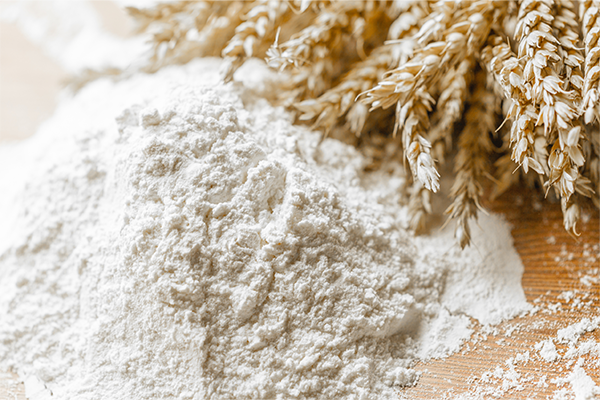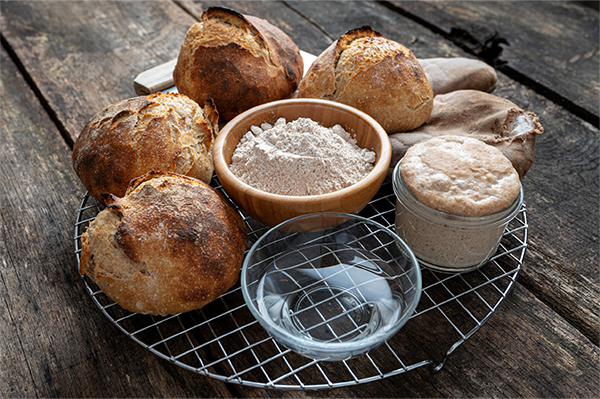
Updating Breadmaking from Seed to Slice
01 October 2024Changing yeast varieties and grain types takes an ages-old process into the modern world.
By Lisa Parrish, GMC Editor
Feedback & comments: This email address is being protected from spambots. You need JavaScript enabled to view it.
Ancient civilizations used natural starters like wild yeast to begin the long and slow process of leavening water and flour. Wild yeast is not some sort of Einstein-looking microorganism with uncombable hair, but a naturally occurring substance found in nature that when coupled with a bacterium begins the lengthy fermentation process. People have baked bread with this process for millennia before the advent of commercial yeast, which began in the late 1800s.
Commercial yeast, also called saccharomyces cerevisiae, became readily available in the US after a Hungarian-born immigrant baker began producing compressed cake yeast which was faster and more predictable than traditional starters. The baker – Charles Fleischmann – and his brother transformed the bread industry into what we know today.
But change is the one thing artisan bakers can count on and it is what consumers are seeing in the marketplace. Bread bakers are updating the process again by utilizing a combination of fermentation methods along with diverting from mass-produced flours to locally milled flours produced from regional crops grown sustainably.
Certified Master Baker and Certified Bread Baker Melina Kelson, education and events manager at Bread Bakers Guild of America, suggests “learning to bake without using commodities can lead to a healthy product with less processing and delicious flavor.”
Flour power
Flour is and has always been the foundation of bread baking and changing this staple can dramatically change its texture and flavor. Some young chefs consider white, sifted flour the go-to ingredient for baked bread. However, white flour is made from a milling process that removes the wheat bran and germ, which contain most of the fiber and nutrients.
Kelson suggests searching for a local mill to buy either unsifted or sifted flour made from local wheat varieties. She shared that there is new research testing different grain varieties that taste delicious and are resilient to climate change and extreme weather events. Instructors who live on the East Coast can check out regional options through the Northern Grain Grower Collaboration, while educators who live on the West Coast can look to the Washington State University Bread Lab for more local wheat and grain information.
“It’s about learning how to bake with ingredients sourced for their sustainability,” she said. “It’s less about recipes and more about understanding grain variety and the benefits of using the whole grain.”
 Melding fermentation processes
Melding fermentation processes
Bulk fermentation, a newer fermentation process utilizing commercial yeast, finishes more quickly than pre-fermentation allowing the baker to bake the loaf quicker. However, while increasing fermentation speed, nutritional and digestibility quality is lost. More fermentation time gives the process a chance to break down gluten and complex carbohydrates, making the bread more digestible. This may be why gluten-sensitive people may tolerate pre-fermented wild yeast breads like sourdough.
Pre-fermentation, or using part of the dough or flour mixture before the final dough is made, takes fermentation time and how much depends on the pre-ferment type. Each type delivers a unique flavor profile and texture. Also note, each of these varieties uses both wild and commercial yeast together for the starter dough.
Poolish
- Characteristics: A wet sponge made with equal parts flour and water, plus a small amount of yeast. It has a fermentation period of between 15 and 18 hours and is used in French-style breads such as baguettes, country loaves, and other crusty breads.
- Purpose: Poolish enhances flavor with a slight acidity and adds a light, open crumb to bread. It produces a mild flavor while improving dough extensibility.
Biga
- Characteristics: A firmer, drier pre-ferment compared to poolish, with a lower water content (about 50-60% hydration). It ferments at room temperature between 15 and 18 hours. Biga is often used in Italian breads, such as ciabatta and focaccia.
- Purpose: Biga adds complexity to the flavor and strengthens the dough’s structure, leading to a more robust, chewy texture. It’s useful for achieving a crispy crust and an airy crumb.
Pâte Fermentée (Old Dough)
- Characteristics: This uses a portion of already-fermented dough, either from a previous batch or left over from earlier in the process. It is mixed into the new dough, often with equal amounts of new ingredients. It ferments quickly between four and six hours because of the quantity of yeast from both doughs.
- Purpose: Pâte fermentée imparts a deep flavor with a subtle acidity, improving both the taste and structure of the bread. It's used in rustic breads like French bâtard and sourdough.
Sponge
- Characteristics: Similar to poolish but typically contains more yeast and a shorter fermentation period of one to two hours. It has a sponge-like consistency.
- Purpose: Sponge develops flavor more quickly than poolish and creates a tighter crumb and chewy texture. It’s often used in bagels, sandwich bread and enriched doughs like brioche and panettone.
Why use different types of pre-fermentation?
- Flavor development: Pre-ferments allow enzymes and yeast to break down complex carbohydrates into simpler sugars, creating deeper, more complex flavors.
- Dough strength: Pre-ferments develop gluten, providing strength and structure to the dough, which improves handling and baking characteristics.
- Leavening power: Pre-fermentation can enhance the natural yeast activity, leading to better leavening with less added yeast.
- Texture enhancement: Pre-ferments contribute to an open crumb, chewy texture, and crispy crust, depending on the dough’s hydration and type of bread.
Source: Erin Jeanne McDowell
When discussing the reason for taking the extra time to use a pre-fermentation method, Kelson said, “I can make a baguette with a straight double fermentation method and it will be bland. I can also use the poolish method with liquid pre-ferment and the dough will have stretch and be nuttier. Using a pre-ferment method makes the bakers’ lives and consumers’ experience better.”
